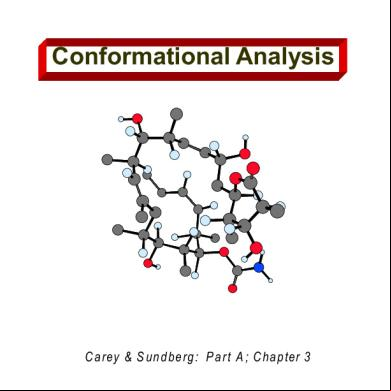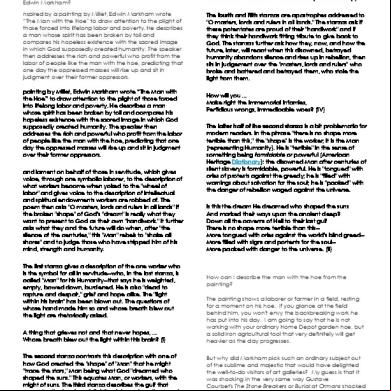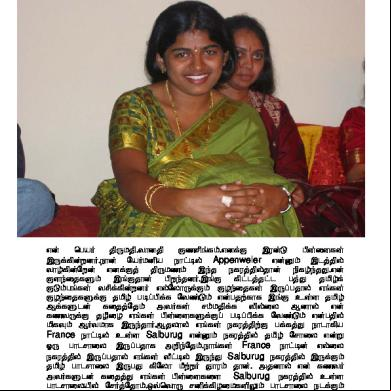Conformational Analysis 52t2a
This document was ed by and they confirmed that they have the permission to share it. If you are author or own the copyright of this book, please report to us by using this report form. Report 3i3n4
Overview 26281t
& View Conformational Analysis as PDF for free.
More details 6y5l6z
- Words: 4,013
- Pages: 53
m
m m
m á i á
i
m
m
m
m
m
m
m
m
Different conformations
Different configurations
monformations of ethane Eclipsed co formatio
taggered co formatio
J
m
Wedge-a d-das str ct res
m
m
m
J
Saw orse projectio s
Newma projectio s
J
m m @ torsion
otential energy of ethane as function of torsion angles
ástaggere conformation has otential energy minimum áecli se conformation has otential energy maximum á staggere conformation is lo er in energy than the ecli se by 2 kcal/mole (12 kJ/mole)
hy is the ecli se conformation higher in energy than the staggere conformation?
áRhe H-atoms are too small to get in each other¶s ay-steric factors make u < 10% of the rotational barrier in ethane
Rorsional strain mause by re ulsion of the bon ing electrons of one substituent ith the bon ing electrons of a nearby substituent
fille orbitals re el
m mx mx
Rhe real icture is robably a mixture of all 3 effects á Rhe rotational barrier is (12 kJ/mol) small enough to allo the conformational isomers to interconvert million of times er secon
monformations of butane
m
otential energy of butane as a function of torsion angle
ÿ D D ÿ D mÿ D D ÿ D D
mÿ D D Ô
m
ÿ D D
m ! " # á malculations reveal that at room tem erature ~72% of the molecules of butane are in the ³anti´ conformation, 28% are in ³gauche´ conformation ÿ D
m
ÿ D D
m
6 6 6 6
A
A
A
^
A
66
! !
" # # #
monformations an monformers Butane can exit in an infinite number of conformations (6 most im ortant have been consi ere ), but has only 3 conformers ( otential energy minima)-the t o ³gauche´conformations an the ³anti´ conformations á R - -
6 66
# $ %& $ %
6 666 6
^ ' (
& $
&
&$ ^ @' ')* A + (
& $
6 666 6
î
î
î
6 6
î
, & ( & $ (
& #
6 666 6
î
î
î
6 6
î
& $ !
, & ( & $ (
& #
monformation an hy rogen bon ing
monformation of butane-2,3- iols
mycloalkanes Ring strain o of atoms in ring
3 4 6 7 8
Internal angle in lanar ring
600 00 1080 1200 128 0 130
* a measure of strain er m-atom
All internal angles 10 0m
10 0-internal angle*
4 0 1 0 1 0 -10 0 -1 0 -2 0
u 3 u u u u
áRing strain largest for 3-membere rings, then ecreases through a 4-membere ring an reaches a minimum for member ring
áre iction: lanar -membere ring shoul have the minimum level of ring strain
áRhe ring strain kee s on increasing as the rings get larger after the minimum at
á the ifference bet een any t o in series is very nearly constant at aroun ±660 kJ/mole á assuming there is no strain in the straight-chain alkanes, each extra ±mH2 grou contributes an extra 68 7 kJ/mole to the heat of combution á if cycloalkane is strain free, its heat of combustion shoul be n X 68 7 kJ/mole If there is some strain ,more energy is given out on combustion
Look at the gra h hich sho s, for each ring size: (a) angle strain er mH2 grou (b) heat of combustion er mH2 grou
á Rhe greatest strain is in the 3-membere ring
á Rhe strain ecreases ith ring size an reaches a minimum for 6-membere ring
á Rhe strain then increases, but not as quickly as the angle calculation suggeste : it reaches a maximum at an then ecreases
á Rhe strain remains constant at ~14, not increases stea ily as the angle-strain suggeste
á J $
á % $
myclic com oun s t ist an ben to minimize the 3 ifferent kin s of strain 1 Angle strain 2 Rorsional strain 3 teric strain myclo ro ane á banana bon s oor orbital overla
HmH 11
& '()
áRorsional strain
. '% +% m &* m+Jÿ ' , (m+-ÿ %
Goo overla trong bon
oor overla eak bon
myclobutane
to re uce torsional angle myclobutane
, %)
6
$
# # & $
# - (
^
( î
6 . # $
# & & ( # ( ( $
6 . # $
# & ( ) &
& & *
×
×
×
× × ×
×
myclo entane
× ×
×
×
×
× ×
& × ×
× ×
×
×
×
× ×
× ×
×
×
× ×
×
áone carbon atom is bent u ar s áRhe molecule is flexible an shifts conformation constantly áHence each of the carbons assume the ivotal osition in ra i succession
áRhe a itional bon angle strain in this structure is more than com ensate by the re uction in ecli se hy rogens
á ith little torsional strain an angle strain, cyclo entane is as stable as cyclohexane
66
$
R /( ( 0 %1 # */ 0 R m 2
# & ( & $ $
$
)#
( & $ *
# & $
$ $ $
)# - ( * î î . # $
) & $ *
$ )$ $ *
. # / ( & & $
& ( ( #
myclohexane
mhair conformation
flag ole hy rogens (- ×
×
um of the van er
aals ra ii = 2 4 A0
× × Boat conformation
× × ××
×
×
e man rojection of the boat conformation
×
× ×
×
×
×
×
×
× ×
×
×
×
×
× × ×
× ×
× ×
6 6 66
×
× ×
m
m
R
m
R
m
m
m
^
R
á Rhe energy ifference bet een the chair, boat, an t ist conformation of cyclohexane are lo enough to make their se aration im ossible at r t At room tem erature a rox 1 million introversions occur each other secon
á ore than % of the molecules are estimate to be in chair conformation at any given time
onosubstitute cyclohexane ±
± Rhis conformation is lo er in energy
hy? ×
±
hen X=mH3, conformer ith e in axial is higher in energy by 7 3 kJ/mol than the corres on ing equatorial conformer
Result: 20:1 ratio of equatorial:axial conformer at 200 m
×
1,3- iaxial interaction
±
±
×
Rhe black bon s are antieri lanar (only one air sho n)
× ×
±
Rhe black bon s are synclinal (gauche) (only one air sho n)
±
±
monc of equatorial conformer "3 monc of axial conformer
±
u
u
uu
uu
m ©× ©×
©× 3
©×
×
×
R
x î
©×
î ©×
favo red
î ©×
m×
m× m× m× m×
m× 1 gauche-butane interaction 0 kcal/mol
4 gauche-butane interaction 4 x 0 kcal/mol = 3 6 kcal/mol
Difference in stability bet een the conformational isomers
3 6 - 0 = 2 7 kcal/mol
3
m×
m×
m×
m×
m× m× m×
×m
This has 3 gauche-butane interactions
, *
2 /Y0
m×
3 m× m×
×m
m×
m×
>ery ba steric situation ~ kcal/mol (4 x 0 = 3 6 kcal/mol + ethyl-ethyl interaction) m×
m×
m×
×m m× m×
It is a resolavable molecule 2-gauche-butane interaction = 1 8 kcal/mol
m×
m×
×m m×
m× m×
' 2'* !3(-1 # m×
m× ×m m×
m×
R 6 6
m×
roblem: hich of the follo ing com oun s are resolvable, an hich are non resolvable? hich are truly meso? a) cis-1,2-cyclohexane iol; b) trans-1,2-cyclohexane iol; c) cis-1,3-cyclohexane iol; ) trans-1,3-cyclohexane iol; e) cis-1,4-cyclohexane iol; f) trans-1,4-cyclohexane iol
Hint: ©H ©H ©H ©H
©H ©H ©H on resolvable (easily interconvertible by fli
©H trans (resolvable) ing) ©H
©H H©
©H
©H
©H
cis (meso)
trans (resolvable) ©H
©H H©
H©
©H ©H
achiral (absence of chirality center)
6
)A *
0 1 ) *
2 )A *
0 1 2 )A - 3 *
0 1 & & $ /
4 2 4 5 3 - +
6
2 61 &
+
+
0
# 1 8 +
$
7
+
+
1 # 8 + $
6
& $ ^
-
+
)$ " * )$ * ) *
< -
2 )2 * 6 1 &
9
# & $ +
9 $ - +
5 7 : & ; 0 3 + 3
Rigi molecules from cyclohexane conformers
monformational equilibrium in 1- henyl-1-methyl cyclohaxane
©H
m©2H
©
©
H© m©2H Lactonization of 3-hy roxy cyclohexane carboxylic aci
m©2H m© H 2
©
©
©
H©2m m©2H myclic anhy ri e formation from 1,3-cyclohexane icarboxylic aci
©H
©H
©
H© ©H
Intramolecular H-bon ing in 1,3cyclohexane iol
H ©
H
6 6 6
+
9
+
-
0 $ $
& $ & $ & & &
2
1 1 = # $ 3 3 #
5 & ) *
#
^ >?
^ > A -
u@m
m & (
# m u@m m - u@m
^ >) * ) *
- (
& #
( & #
î
î
2 eliminations have anti- eri lanar transition states R 6 6 × 6 ± 6
In 2 eliminations, the ne R bon is forme by overla of the m-H x bon ith the m-X x* antibon ing orbital
2 eliminations have anti- eri lanar transition states
î 6 6 6
î 6 6 6
o
m
©6 6 6
©×
m m
(faster) m
m p
×
p
×
m×
×
m
(slower)
m p
p
m
p
×
×
m
©×
m
×
m
×
m×
×
p
m×
×
m
×
×
×
m
m
m
m
m%×%4
m m
m m
xhereas
m
m
m
m%×%4
m m
m m
m
m m m
m%×%4
m
m m
m
m
m m
roblem: ©n treatment ith the aromatic base yri ine, racemic 1,2- ibromo-1,2- i henyl ethane loses HBr to yiel trans-1-bromo-1,2- i henyl ethane; In contrast the meso ibromi e loses Br 2 to yiel trans-1,2- i henyl ethene uggets a mechanism? Hnit: Br
Br h
H
H
Br
h
h Br
H
H
H
H
h
h
Br
Br2 loss is not favore
Br
h Racemic
H h H h
h H
hH
Br
H
Br h meso
H
h Br
Br
H
Br
-HBr
Br
Br h h
Br Br
h h
h H
-Br2 h
m m
m á i á
i
m
m
m
m
m
m
m
m
Different conformations
Different configurations
monformations of ethane Eclipsed co formatio
taggered co formatio
J
m
Wedge-a d-das str ct res
m
m
m
J
Saw orse projectio s
Newma projectio s
J
m m @ torsion
otential energy of ethane as function of torsion angles
ástaggere conformation has otential energy minimum áecli se conformation has otential energy maximum á staggere conformation is lo er in energy than the ecli se by 2 kcal/mole (12 kJ/mole)
hy is the ecli se conformation higher in energy than the staggere conformation?
áRhe H-atoms are too small to get in each other¶s ay-steric factors make u < 10% of the rotational barrier in ethane
Rorsional strain mause by re ulsion of the bon ing electrons of one substituent ith the bon ing electrons of a nearby substituent
fille orbitals re el
m mx mx
Rhe real icture is robably a mixture of all 3 effects á Rhe rotational barrier is (12 kJ/mol) small enough to allo the conformational isomers to interconvert million of times er secon
monformations of butane
m
otential energy of butane as a function of torsion angle
ÿ D D ÿ D mÿ D D ÿ D D
mÿ D D Ô
m
ÿ D D
m ! " # á malculations reveal that at room tem erature ~72% of the molecules of butane are in the ³anti´ conformation, 28% are in ³gauche´ conformation ÿ D
m
ÿ D D
m
6 6 6 6
A
A
A
^
A
66
! !
" # # #
monformations an monformers Butane can exit in an infinite number of conformations (6 most im ortant have been consi ere ), but has only 3 conformers ( otential energy minima)-the t o ³gauche´conformations an the ³anti´ conformations á R - -
6 66
# $ %& $ %
6 666 6
^ ' (
& $
&
&$ ^ @' ')* A + (
& $
6 666 6
î
î
î
6 6
î
, & ( & $ (
& #
6 666 6
î
î
î
6 6
î
& $ !
, & ( & $ (
& #
monformation an hy rogen bon ing
monformation of butane-2,3- iols
mycloalkanes Ring strain o of atoms in ring
3 4 6 7 8
Internal angle in lanar ring
600 00 1080 1200 128 0 130
* a measure of strain er m-atom
All internal angles 10 0m
10 0-internal angle*
4 0 1 0 1 0 -10 0 -1 0 -2 0
u 3 u u u u
áRing strain largest for 3-membere rings, then ecreases through a 4-membere ring an reaches a minimum for member ring
áre iction: lanar -membere ring shoul have the minimum level of ring strain
áRhe ring strain kee s on increasing as the rings get larger after the minimum at
á the ifference bet een any t o in series is very nearly constant at aroun ±660 kJ/mole á assuming there is no strain in the straight-chain alkanes, each extra ±mH2 grou contributes an extra 68 7 kJ/mole to the heat of combution á if cycloalkane is strain free, its heat of combustion shoul be n X 68 7 kJ/mole If there is some strain ,more energy is given out on combustion
Look at the gra h hich sho s, for each ring size: (a) angle strain er mH2 grou (b) heat of combustion er mH2 grou
á Rhe greatest strain is in the 3-membere ring
á Rhe strain ecreases ith ring size an reaches a minimum for 6-membere ring
á Rhe strain then increases, but not as quickly as the angle calculation suggeste : it reaches a maximum at an then ecreases
á Rhe strain remains constant at ~14, not increases stea ily as the angle-strain suggeste
á J $
á % $
myclic com oun s t ist an ben to minimize the 3 ifferent kin s of strain 1 Angle strain 2 Rorsional strain 3 teric strain myclo ro ane á banana bon s oor orbital overla
HmH 11
& '()
áRorsional strain
. '% +% m &* m+Jÿ ' , (m+-ÿ %
Goo overla trong bon
oor overla eak bon
myclobutane
to re uce torsional angle myclobutane
, %)
6
$
# # & $
# - (
^
( î
6 . # $
# & & ( # ( ( $
6 . # $
# & ( ) &
& & *
×
×
×
× × ×
×
myclo entane
× ×
×
×
×
× ×
& × ×
× ×
×
×
×
× ×
× ×
×
×
× ×
×
áone carbon atom is bent u ar s áRhe molecule is flexible an shifts conformation constantly áHence each of the carbons assume the ivotal osition in ra i succession
áRhe a itional bon angle strain in this structure is more than com ensate by the re uction in ecli se hy rogens
á ith little torsional strain an angle strain, cyclo entane is as stable as cyclohexane
66
$
R /( ( 0 %1 # */ 0 R m 2
# & ( & $ $
$
)#
( & $ *
# & $
$ $ $
)# - ( * î î . # $
) & $ *
$ )$ $ *
. # / ( & & $
& ( ( #
myclohexane
mhair conformation
flag ole hy rogens (- ×
×
um of the van er
aals ra ii = 2 4 A0
× × Boat conformation
× × ××
×
×
e man rojection of the boat conformation
×
× ×
×
×
×
×
×
× ×
×
×
×
×
× × ×
× ×
× ×
6 6 66
×
× ×
m
m
R
m
R
m
m
m
^
R
á Rhe energy ifference bet een the chair, boat, an t ist conformation of cyclohexane are lo enough to make their se aration im ossible at r t At room tem erature a rox 1 million introversions occur each other secon
á ore than % of the molecules are estimate to be in chair conformation at any given time
onosubstitute cyclohexane ±
± Rhis conformation is lo er in energy
hy? ×
±
hen X=mH3, conformer ith e in axial is higher in energy by 7 3 kJ/mol than the corres on ing equatorial conformer
Result: 20:1 ratio of equatorial:axial conformer at 200 m
×
1,3- iaxial interaction
±
±
×
Rhe black bon s are antieri lanar (only one air sho n)
× ×
±
Rhe black bon s are synclinal (gauche) (only one air sho n)
±
±
monc of equatorial conformer "3 monc of axial conformer
±
u
u
uu
uu
m ©× ©×
©× 3
©×
×
×
R
x î
©×
î ©×
favo red
î ©×
m×
m× m× m× m×
m× 1 gauche-butane interaction 0 kcal/mol
4 gauche-butane interaction 4 x 0 kcal/mol = 3 6 kcal/mol
Difference in stability bet een the conformational isomers
3 6 - 0 = 2 7 kcal/mol
3
m×
m×
m×
m×
m× m× m×
×m
This has 3 gauche-butane interactions
, *
2 /Y0
m×
3 m× m×
×m
m×
m×
>ery ba steric situation ~ kcal/mol (4 x 0 = 3 6 kcal/mol + ethyl-ethyl interaction) m×
m×
m×
×m m× m×
It is a resolavable molecule 2-gauche-butane interaction = 1 8 kcal/mol
m×
m×
×m m×
m× m×
' 2'* !3(-1 # m×
m× ×m m×
m×
R 6 6
m×
roblem: hich of the follo ing com oun s are resolvable, an hich are non resolvable? hich are truly meso? a) cis-1,2-cyclohexane iol; b) trans-1,2-cyclohexane iol; c) cis-1,3-cyclohexane iol; ) trans-1,3-cyclohexane iol; e) cis-1,4-cyclohexane iol; f) trans-1,4-cyclohexane iol
Hint: ©H ©H ©H ©H
©H ©H ©H on resolvable (easily interconvertible by fli
©H trans (resolvable) ing) ©H
©H H©
©H
©H
©H
cis (meso)
trans (resolvable) ©H
©H H©
H©
©H ©H
achiral (absence of chirality center)
6
)A *
0 1 ) *
2 )A *
0 1 2 )A - 3 *
0 1 & & $ /
4 2 4 5 3 - +
6
2 61 &
+
+
0
# 1 8 +
$
7
+
+
1 # 8 + $
6
& $ ^
-
+
)$ " * )$ * ) *
< -
2 )2 * 6 1 &
9
# & $ +
9 $ - +
5 7 : & ; 0 3 + 3
Rigi molecules from cyclohexane conformers
monformational equilibrium in 1- henyl-1-methyl cyclohaxane
©H
m©2H
©
©
H© m©2H Lactonization of 3-hy roxy cyclohexane carboxylic aci
m©2H m© H 2
©
©
©
H©2m m©2H myclic anhy ri e formation from 1,3-cyclohexane icarboxylic aci
©H
©H
©
H© ©H
Intramolecular H-bon ing in 1,3cyclohexane iol
H ©
H
6 6 6
+
9
+
-
0 $ $
& $ & $ & & &
2
1 1 = # $ 3 3 #
5 & ) *
#
^ >?
^ > A -
u@m
m & (
# m u@m m - u@m
^ >) * ) *
- (
& #
( & #
î
î
2 eliminations have anti- eri lanar transition states R 6 6 × 6 ± 6
In 2 eliminations, the ne R bon is forme by overla of the m-H x bon ith the m-X x* antibon ing orbital
2 eliminations have anti- eri lanar transition states
î 6 6 6
î 6 6 6
o
m
©6 6 6
©×
m m
(faster) m
m p
×
p
×
m×
×
m
(slower)
m p
p
m
p
×
×
m
©×
m
×
m
×
m×
×
p
m×
×
m
×
×
×
m
m
m
m
m%×%4
m m
m m
xhereas
m
m
m
m%×%4
m m
m m
m
m m m
m%×%4
m
m m
m
m
m m
roblem: ©n treatment ith the aromatic base yri ine, racemic 1,2- ibromo-1,2- i henyl ethane loses HBr to yiel trans-1-bromo-1,2- i henyl ethane; In contrast the meso ibromi e loses Br 2 to yiel trans-1,2- i henyl ethene uggets a mechanism? Hnit: Br
Br h
H
H
Br
h
h Br
H
H
H
H
h
h
Br
Br2 loss is not favore
Br
h Racemic
H h H h
h H
hH
Br
H
Br h meso
H
h Br
Br
H
Br
-HBr
Br
Br h h
Br Br
h h
h H
-Br2 h











